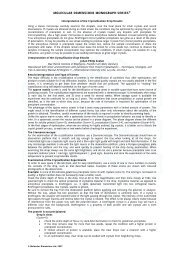(IEA Energy Papers 2011_05) Matthias Finkenrath-Cost and Performance of Carbon Dioxide Capture from Power Generation (IEA Energy Papers)-OECD Publishing (2011)
You also want an ePaper? Increase the reach of your titles
YUMPU automatically turns print PDFs into web optimized ePapers that Google loves.
<strong>Cost</strong> <strong>and</strong> <strong>Performance</strong> <strong>of</strong> <strong>Carbon</strong> <strong>Dioxide</strong> <strong>Capture</strong> <strong>from</strong> <strong>Power</strong> <strong>Generation</strong> ©<strong>OECD</strong>/<strong>IEA</strong> <strong>2011</strong><br />
Page | 16<br />
PCGE 2010 publication. The underlying philosophy <strong>and</strong> methodology behind the calculation is<br />
discussed in detail in the <strong>OECD</strong> publication <strong>and</strong> not repeated in this paper.<br />
Based on <strong>IEA</strong> <strong>and</strong> NEA convention, a key assumption <strong>of</strong> the LCOE approach is that the interest<br />
rate used for discounting costs does not vary over the lifetime <strong>of</strong> the project under consideration.<br />
A real discount rate <strong>of</strong> 10% is used for all cases in this study, which is the higher <strong>of</strong> two discount<br />
rates defined in the PCGE 2010 study. This figure is chosen for this study because <strong>of</strong> an<br />
anticipated higher technical <strong>and</strong> financial risk associated with investments in CCS technologies in<br />
the early phase <strong>of</strong> commercialisation. It should be noted that apart <strong>from</strong> considerations about<br />
technology maturity, other factors (such as the type <strong>of</strong> plant ownership) influence the cost <strong>of</strong><br />
financing a project. This would be reflected in the applicable discount rates.<br />
LCOE is also used as a basis for providing estimates <strong>of</strong> costs <strong>of</strong> CO 2 avoidance for different<br />
capture technologies. Further background on the terminology, including how to derive CO 2<br />
avoidance costs are extensively discussed in previous publications. This includes important<br />
considerations related to selecting a meaningful reference power plant without CCS for calculating<br />
cost <strong>of</strong> CO 2 avoided (IPCC, 20<strong>05</strong>; GCCSI, 2009).<br />
It is important to note that in contrast to the <strong>OECD</strong> PCGE 2010 publication, reported LCOE data<br />
do not include a USD 30/tCO 2 emission price, since this approach is less common for CCSrelated<br />
cost comparisons. Hence in this working paper no CO 2 emission price is added for<br />
calculating LCOE.<br />
Conversion <strong>and</strong> calibration <strong>of</strong> cost data<br />
Several methodologies are used to estimate economic data, in particular capital costs, <strong>of</strong> CO 2<br />
capture <strong>from</strong> power generation. There is neither a st<strong>and</strong>ardised methodology nor a set <strong>of</strong><br />
commonly agreed on boundary conditions, which adds to the complexity <strong>of</strong> comparing data <strong>from</strong><br />
different studies. Moreover, some factors are <strong>of</strong>ten not fully transparent, such as costing<br />
methodologies, sources <strong>of</strong> costs, the exact scope <strong>of</strong> data as well as assumptions on individual<br />
cost parameters. As a consequence, it is not straightforward to transform techno‐economic<br />
information <strong>from</strong> different studies into a comparable set <strong>of</strong> data.<br />
Though there is no consistently applied approach for cost evaluation, similarities exist<br />
throughout studies in terms <strong>of</strong> how CO 2 capture costs are conceptually assessed. <strong>Cost</strong> data are<br />
usually split into capital costs (related to the construction <strong>of</strong> equipment), fuel costs, <strong>and</strong> nonfuel<br />
operating <strong>and</strong> maintenance costs (related to the process <strong>and</strong> its equipment). These costs<br />
are commonly used together to calculate the first year cost <strong>of</strong> electricity (COE) or LCOE over<br />
the lifetime <strong>of</strong> the plant.<br />
Sources <strong>of</strong> capital costs are <strong>of</strong>ten not clearly stated in publications. Typically, costs are based on<br />
estimates for main equipment or process isl<strong>and</strong>s that are provided by vendors or taken <strong>from</strong><br />
equipment cost databases. Often equipment costs are readjusted (using scaling laws) to the<br />
specific process conditions, <strong>and</strong> costs are added for installation <strong>and</strong> indirect expenses required<br />
for the complete construction <strong>of</strong> the plant.<br />
Assumptions about additional capital expenses vary across studies or are not clearly reported.<br />
Examples <strong>of</strong> these additional capital costs include engineering <strong>and</strong> overhead, commissioning expenses,<br />
or process <strong>and</strong> equipment contingencies. In some instances, the same terms are used differently.<br />
For consistency with previous <strong>OECD</strong> studies – <strong>and</strong> in order to reduce the impact <strong>of</strong> projectspecific<br />
cost elements – this study uses overnight costs as the key metric for quantifying capital<br />
cost. According to <strong>OECD</strong> terminology, overnight costs include:




